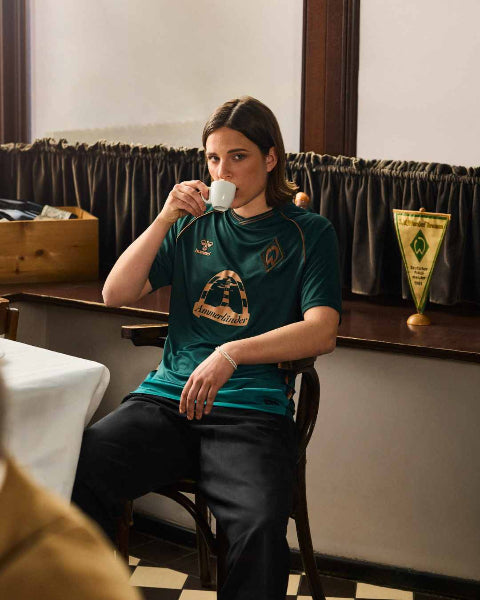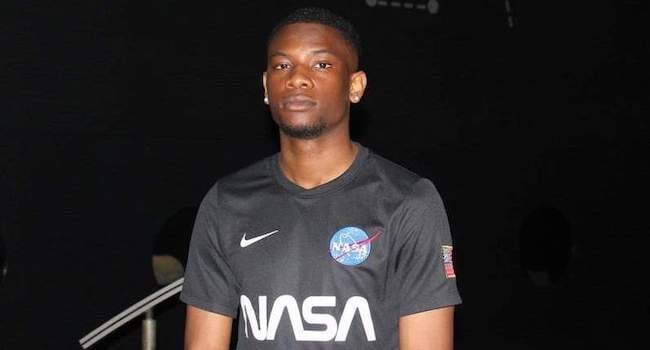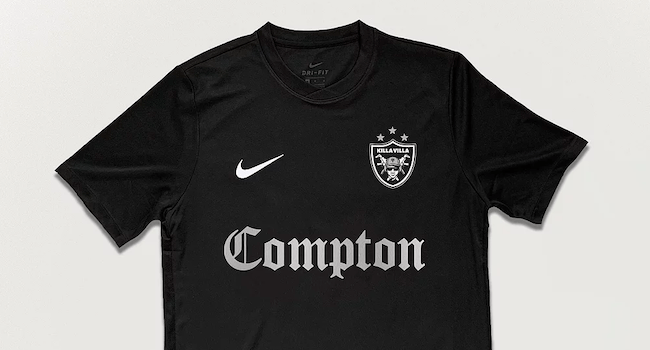Recently added
Vintage shirts
Concept kits
Legends
“We are not normal” - The story of FC Nordsjӕlland
by Matt Leslie February 05, 2022 8 min read

FC Nordsjӕlland had just beaten Aarhus 2-0, and the Danish Superliga side’s manager, Flemming Pedersen, spoke to his players, and delivered a phrase that is now firmly part of Nordsjӕlland’s ethos: “We are not normal. But I really like not being normal.”
“It was proof that we can win with our model,” says the club’s Head of Marketing, Sebastián Morúa Hernandez, who we got to speak to this week. “And the manager just got up and said that as a pep talk after the game, but now we’re just using it to explain everything we do.”
That phrase also now sits in the bios of Nordsjӕlland’s social accounts.
And in many ways, Pederson could not have put it better, because Nordsjӕlland really are not a normal football club. But while his comment may have been an off-the-cuff soundbite, the club’s journey to this abnormal status is anything but an accident, but rather part of a near two decade journey.
This is a closer look at that journey, and how it has shaped the club, its players, and potentially the entire football community.
Beginnings
Officially founded in 2003, FC Nordsjӕlland were born out of their ‘mother club’ - a team whose license new owners buy to form the club - Farum BK, located in Farum, in the Sjӕlland region of Denmark which also hosts Copenhagen and Brøndby. This places the club in a true heartland of Danish football culture, and as such they would have to stand out to gain support amongst Denmark’s traditional ‘big two’ clubs.
“The new owner thought it would be worth rebranding,” Sebastián tells us. “He rebranded to include a larger region of the club’s area, which is the North part of Sjӕlland, hence the name ‘Nordsjӕlland’.”
With that rebrand also came a new logo, revamped colour scheme and the adoption of a tiger as the club’s mascot - a move which Sebastián says was a tongue-in-cheek goading of their rivals in Copenhagen. “The tiger is the biggest cat in the cat world, and FC Copenhagen has a lion. So it was like saying ‘you have the bigger club but we have the bigger cat’.”
🐯❤️ #TimbaLove pic.twitter.com/45CXbecZJi
— FC Nordsjælland 🐯 (@FCNordsjaelland) July 29, 2018
The proceeding period saw rapid growth, as Nordsjӕlland defied the odds to compete in the Danish Superliga, culminating in a “golden period” between 2010 and 2013, in which the club won the Danish Cup, a first league title and qualified for the Champions League group stages.
All of this progress was achieved with an approach that centred around one aspect in particular: youth.
Trust the kids
Those glory years in the early 2010s are just some examples of the growing collection of moments that have proved FC Nordsjӕlland’s somewhat alternative approach to running a football club were entirely justified.
Since then there has been that win over Aarhus - one in which the average age of of the Nordsjӕlland team was just 20 years and 20 days old, and 80% composed of academy graduates. And after that, even more justification has come in the shape of former academy graduate, Mikkel Damsgaard, who seamlessly filled in for Christian Eriksen in Denmark’s Euro 2020 semi-final run.
The home shirt 🔴🟡
— Football Shirt Collective (@thefootballsc) October 15, 2021
"We used to have thick yellow & red stripes, But when FC Nordsjælland was created, red became our prominent colour. So the thin yellow lines, are trying to show that the yellow is going away and the red is taking over."
[THREAD🐯] pic.twitter.com/DONCV8u0hX
Now at Sampdoria, Damsgaard, who judging by his career so far has a penchant for playing extremely beautiful shirts, is an example of the strategy in Farum: to gather players from a young age and provide early first team opportunities, hopefully allowing them to catch the eye of scouts across Europe, thus creating a self-sustaining transfer model.
Damsgaard is far from the only name to emerge from the Nordsjӕlland academy and make waves in recent years. And this, along with Nordsjӕlland’s title as the youngest squad in Europe’s top 30 leagues, is largely the result of initiatives and ideals installed after the club’s 2015 takeover.
Right To Dream
In 2015, Right to Dream bought FC Nordsjӕlland, and Tom Vernon became the club’s Chairman. A former Manchester United scout, Vernon started Right to Dream as an academy in Ghana, coaching young boys and girls at football, while also providing the resources for valuable life lessons that would last in these children well beyond any potential football career they would have.
Once in the door in Denmark, links were immediately set up to expand the Right to Dream model, and blend the two academies. It is also worth mentioning that FC Nordsjӕlland was by no means a random choice by Right to Dream, but rather chosen specifically for their focus and investment in youth prior to the takeover.
“The Nordsjӕlland we see today was really born with the Right to Dream takeover in 2015. But there were some really strong foundations that were built pre-Right to Dream,” Sebastián, who joined FC Nordsjӕlland after the takeover, told us. “The most important of those was the decision to invest all the winnings from tournaments and the Champions League into the academy. So, Right to Dream and Nordsjӕlland were following the same strategies.”
These cross-continent links led to the creation of the “international academy”, which saw the best players from the academy in Ghana and the best players from the academy in Denmark team-up to compete in tournaments around the world. For the original Right to Dream academy in Ghana, the takeover at Nordsjӕlland also provided a clear pathway for the players being developed there.
Sebastián lays out that the plan is for the youngsters in these academies to eventually become the first team of FC Nordsjӕlland. Damsgaard is a product of this international academy approach, and he played together with Mohammed Kudus, who came through Ghana’s Right to Dream academy, before eventually progressing to join Damsgaard in the Nordsjӕlland first-team. In the Summer of 2020, Kudus joined Ajax for 11m Euros, completing his Right to Dream journey.
This Summer, Kamaldeen Sulemana completed a similar journey, having started in Ghana, before progressing to Nordsjӕlland’s first-team and then onto Rennes for an 11m Euro fee.
✅ @right2dream 🇬🇭
— af•recon (@af_recon) August 8, 2021
✅ @FCNordsjaelland 🇩🇰
✅ @staderennais 🇫🇷
Kamaldeen Sulemana scores on his debut in Ligue 1.
A testament to the exceptional talent on this continent 🌍 pic.twitter.com/OiaDnDb4cS
So thanks to Right to Dream’s ownership of the club, the young boys and girls in Ghana who come through the academy there now have a clear pathway that can see them move into professional football, and potentially into one of Europe’s top leagues.
But for Right to Dream, and as a result FC Nordsjӕlland, it is not about the financial windfall generated by this strategy. The focus is not all about creating world class footballers with high sell-on value, but rather on creating world class human beings.
🐯 BUY NOW 🐯
Creating more than just players
From the minute they were through the doors in Farum, Right to Dream set about implementing the strategies that had worked so well in their Ghana academy in Nordsjӕlland.
“We implemented the Character Development Curriculum, so Danish boys and girls received access to emotional, psychological and social education,” explains Sebastián. ‘“This is to develop character, leadership and purpose. We’re looking for experiences that will push our players out of their comfort zones and question what they know about the rest of the world.”
Character Traits • Adventurous
— Right to Dream (@right2dream) July 7, 2021
An adventurous person is willing to take risks or try out new methods, ideas, or experiences without fear of losing. Their dreams cannot remain unfulfilled. #adventure#adventures#adventurous #adventuretime pic.twitter.com/ljcAsZzQhA
Beyond just an in-built curriculum, Sebastián told us how the club also ensures this model provides active participation through community out-reach programmes. Partnered with local charities, each academy team is required to adopt a community project at the start of the season which they work towards together.
Sebastián explained how this approach clearly rubbed off Damsgaard, who showed his connection to his community following the Euros this Summer.
"Less than 24 hours after 'Dams' scored that free kick banger at Wembley in the Euro’s semi-final, he returned to his childhood club in the little town where he grew up (Jyllinge). He spent time signing autographs to the local boys and girls that have him as their role model. To us, that is what very much what our model is about and also how we believe the next generation of professional athletes should act: Be humble, remember where you came from and always give back."
And Right to Dream are not just intent on developing these qualities in their players, but in their local and wider-communities too.
“We believe that football is a little bit broken,” Sebastián continues. “That’s why we have started a lot of these purpose driven campaigns. We want other clubs and players to see how a football club can be just as a platform for good”
This approach has seen Nordsjӕlland participate in Black History Month, celebrate International Women’s Day, become the first club to sign-up to Common Goal, and most recently release a Pride shirt, with this year’s edition being a plain white jersey with stunning iridescent features. Even a quick look at the club’s social accounts will show a very purposeful difference from many clubs, in that they have no separate accounts for their Women’s and Men’s teams, but rather one fully-integrated account that gives equal space to both teams and their academies.
JERES MAN OF THE MATCH: KIAN HANSEN 🧯🔥 pic.twitter.com/IK2Dd5bBtL
— FC Nordsjælland 🐯 (@FCNordsjaelland) August 13, 2021
The ultimate goal with this approach is to see the players who progress through the Nordsjӕlland and Right to Dream academies take these values with them to future clubs and careers, as Sebastián believes that Damsgaard, Kudus and Sulemana have. This spreads the Right to Dream message, and ensures that their platform, and football’s, continues to give back.
What about the shirts?
By this point, some of you might be asking “Why have I just read an entire blog from the Football Shirt Collective and not heard anything about shirts?” and that’s a valid question, especially considering just how good FC Nordsjӕlland’s shirts are.
Well, there are two reasons we wanted to mainly cover Nordsjӕlland and what they’re about as a club: first, they have such an original and inspiring approach to running a modern football club that we did not want to pass up the opportunity to tell their story, especially after getting time to speak with Sebastián. And second, we still have some of Nordsjӕlland’s 2021/22 home shirt in stock and thought any prospective buyers would like to know a bit more about the club they would be wearing to every game of 5-a-side for the rest of the season.
But for those who want to know a little bit more about the shirt and how it was designed, don’t worry, because we have you covered. Next week we will have a full interview with Sebastián about the 2021/22 home shirt and the Pride jersey, as well as what we should expect from the club’s upcoming away shirt release.
Until then, Phil Delves has written a list of 5 reasons we love the 2021/22 FC Nordsjӕlland shirt, so be sure to have a look at that to tide you over!
If you liked what you heard on FC Nordsjӕlland, why not pick-up their home or away jerseys? Browse them in our Modern Classics collection here.
Sidebar
- Premier League football shirts
-
Other English clubs
- Birmingham City
- Blackburn Rovers
- Charlton Athletic
- Coventry City
- Derby County
- Hull City
- Ipswich Town
- Leicester City
- Middlesbrough
- Millwall
- Norwich City
- Portsmouth
- Preston North End
- Queens Park Rangers
- Sheffield United
- Sheffield Wednesday
- Southampton
- Stoke City
- Swansea City
- Watford
- West Bromwich Albion
- Scottish clubs
- Italian club shirts
- Spanish club shirts
- German club shirts
- International
- French club shirts
- Rest of the world
-
Legends
- Adriano
- Alessandro Del Piero
- Andrey Arshavin
- Alvaro Recoba
- Bobby Moore
- Bryan Robson
- Bukayo Saka
- Clarence Seedorf
- Cristian Vieri
- Cristiano Ronaldo
- David Beckham
- David James
- David Seaman
- David Ginola
- Dennis Wise
- Dennis Bergkamp
- Didier Drogba
- Dimitar Berbatov
- Diego Maradona
- Edgar Davids
- Eric Cantona
- Fernando Torres
- Freddie Ljungberg
- Gabriel Batistuta
- Gianluca Vialli
- Gianluigi Buffon
- Giovanni Elber
- Frank Lampard
- Francecso Totti
- Haaland
- Harry Kane
- Hidetoshi Nakata
- Ian Wright
- Jari Litmanen
- Ji Sung Park
- Juninho
- Jurgen Klinsmann
- Kaka
- Landon Donovan
- Lionel Messi
- Lothar Mattaus
- Luis Figo
- Mark Viduka
- Matt Le Tissier
- Mesut Özil
- Michael Owen
- Mikel Arteta
- Neymar
- Nicolas Anelka
- Nwankwo Kanu
- Paolo Di Canio
- Paolo Maldini
- Patrick Vieira
- Rafael Van der Vaart
- Raul
- Riquelme
- Rivaldo
- Robert Pires
- Roberto Baggio
- Robbie Fowler
- Ronaldo Nazario
- Ronaldinho
- Roy Keane
- Rudi Voller
- Ruud Gullit
- Ryan Giggs
- Santi Carzola
- Steve Bull
- Steven Gerrard
- Teddy Sheringham
- Thierry Henry
- Tony Adams
- Toto Schillaci
- Tugay
- Wayne Rooney
- Xabi Alonso
- Zinedine Zidane
- Zola
- Brands
Subscribe
Sign up to get the latest on sales, new releases and more …













